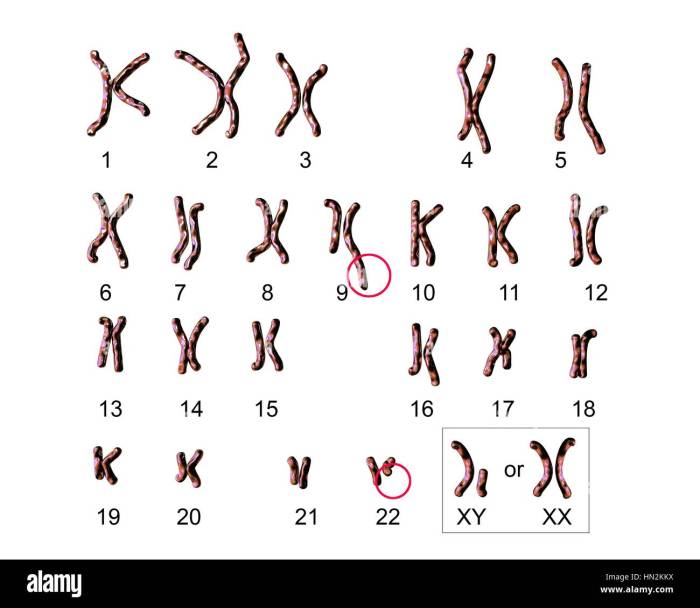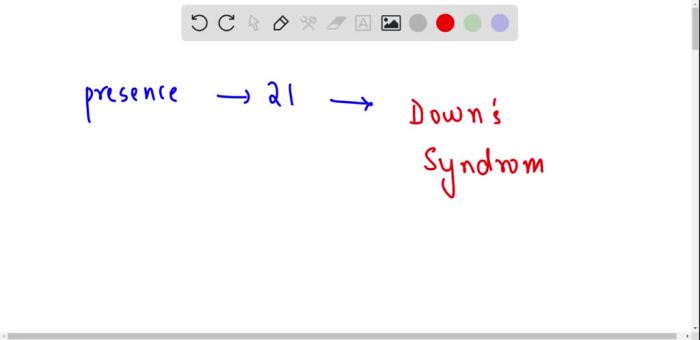The image portrays a representation of a human karyotype, a visual representation of the entire set of chromosomes in a cell. Karyotypes are essential tools in human genetics, providing valuable insights into an individual’s genetic makeup and potential health risks.
This overview will explore the concept of karyotypes, their components, analysis methods, and clinical applications. It will also delve into the role of karyotyping in research and its ethical considerations.
1. Karyotype Overview

A karyotype is a representation of an individual’s chromosomal complement. It is a picture of all the chromosomes in a cell, arranged in a standardized order. Karyotypes are used to study human genetics, diagnose genetic disorders, and perform genetic counseling.
Types of Karyotypes
- Standard karyotype:A karyotype that shows all the chromosomes in a cell, stained with Giemsa dye.
- High-resolution karyotype:A karyotype that shows the chromosomes at a higher resolution, allowing for more detailed analysis.
- Spectral karyotype:A karyotype that uses fluorescent dyes to differentiate between chromosomes, allowing for more accurate identification.
2. Components of a Human Karyotype

A human karyotype consists of 46 chromosomes, which are arranged in 23 pairs. Each pair of chromosomes consists of one chromosome from the mother and one from the father.
Components of a Chromosome
- Chromatids:The two identical strands of DNA that make up a chromosome.
- Centromere:The region of the chromosome where the chromatids are joined.
- Telomeres:The protective caps at the ends of chromosomes.
Banding Patterns
Karyotypes are stained with Giemsa dye to create banding patterns. These patterns allow for the identification of individual chromosomes.
3. Karyotype Analysis
Karyotype analysis is the process of examining a karyotype to identify any abnormalities. Karyotype analysis can be used to diagnose genetic disorders, such as Down syndrome and Turner syndrome.
Methods of Karyotype Analysis
- Microscopy:Karyotypes are typically analyzed using a microscope.
- Digital imaging:Karyotypes can also be analyzed using digital imaging software.
4. Karyotype Representation
Karyotypes can be represented in a variety of ways, including G-banding, FISH, and spectral karyotyping.
G-Banding
G-banding is a staining technique that produces a distinctive banding pattern on chromosomes. This pattern allows for the identification of individual chromosomes.
FISH
FISH (fluorescence in situ hybridization) is a technique that uses fluorescent probes to identify specific regions of chromosomes.
Spectral Karyotyping
Spectral karyotyping is a technique that uses fluorescent dyes to differentiate between chromosomes. This allows for more accurate identification of chromosomes.
5. Clinical Applications of Karyotyping

Karyotyping has a variety of clinical applications, including prenatal diagnosis, cancer diagnosis, and genetic counseling.
Prenatal Diagnosis, The image portrays a representation of a human karyotype
Karyotyping can be used to diagnose genetic disorders in a fetus before birth.
Cancer Diagnosis
Karyotyping can be used to diagnose certain types of cancer, such as leukemia and lymphoma.
Genetic Counseling
Karyotyping can be used to provide genetic counseling to individuals who are at risk for having a child with a genetic disorder.
6. Karyotype in Research

Karyotyping is also used in genetic research and the study of human evolution.
Genetic Research
Karyotyping can be used to identify genetic markers that are associated with certain diseases.
Human Evolution
Karyotyping can be used to study the evolution of humans and other primates.
Questions Often Asked: The Image Portrays A Representation Of A Human Karyotype
What is a karyotype?
A karyotype is a visual representation of the entire set of chromosomes in a cell.
What are the different types of karyotypes?
There are several types of karyotypes, including G-banding, FISH, and spectral karyotyping.
What is the clinical significance of karyotyping?
Karyotyping is used to diagnose genetic disorders, chromosomal abnormalities, and to determine the sex of an individual.